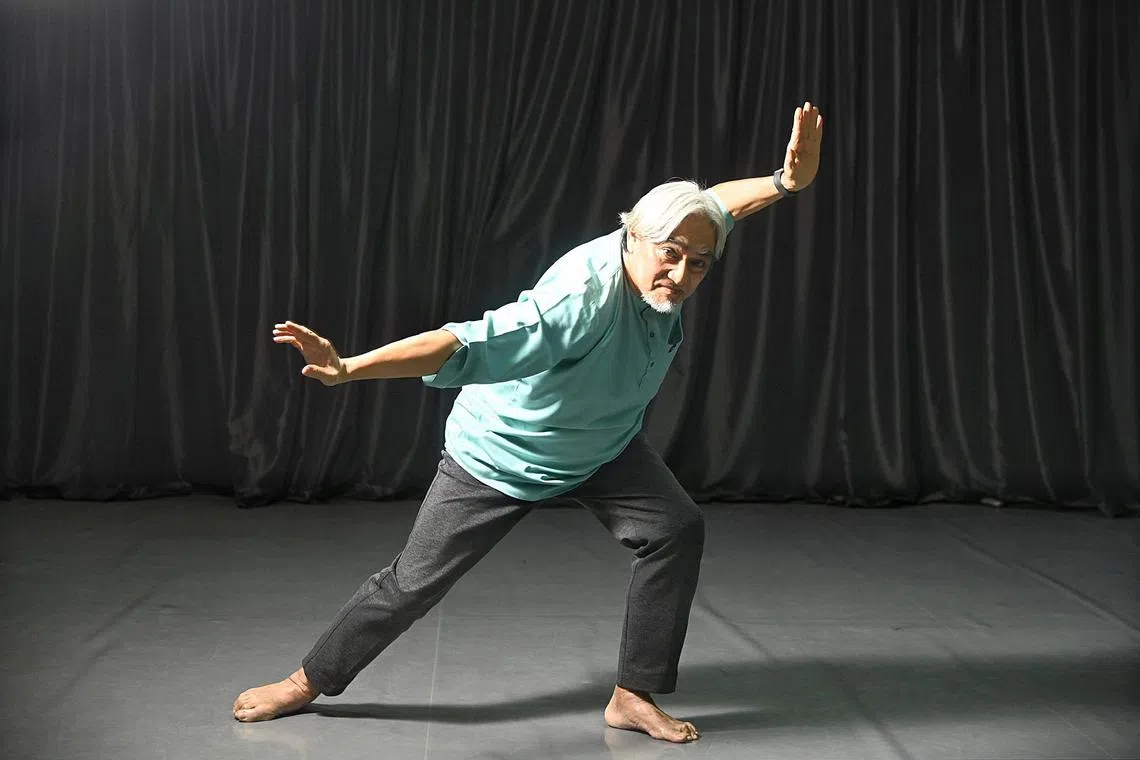Cultural Medallion: Osman Abdul Hamid chose Malay dance over professional football
Sign up now: Get ST's newsletters delivered to your inbox

Malay dance veteran Osman Abdul Hamid received the Cultural Medallion, Singapore's highest arts accolade, on Dec 5.
ST PHOTO: DESMOND WEE
Follow topic:
SINGAPORE – Backflips, cartwheels, hand and head stands. These are not moves one associates with traditional Malay dance, but veteran dancer Osman Abdul Hamid has spent four decades infusing his choreography with such athleticism.
The 61-year-old was, after all, a star sportsman before he became a dancer. An avid hockey player and basketballer, Osman also played football with Tampines Rovers from 1978 to 1981 and even considered going professional.
Foreseeing that a life in sports would mean a life of injuries, he chose a life of dance instead – surely no less injury-prone a career, but he claims never to have suffered a serious injury from dancing. He went on to co-found Era Dance Theatre with Azrin Abdul Rahim and currently serves as its artistic director.
On Dec 5, the acclaimed dancer and choreographer was one of three Cultural Medallion recipients
But back in Upper Serangoon Technical School, the macho sports captain vehemently rejected the coaxing of his friends to join the Malay dance troupe. Speaking at Era Dance Theatre’s home at Goodman Arts Centre, Osman laughs it off but recalls his teenage worry: “The fear is that you turn into a sissy.”
But Osman was to learn from his first teacher, Mr Salleh Buang, that dance could be as athletic as any sport. Mr Salleh’s first two rehearsals – a circuit training regimen that involved running, crawling, frog jumps, duck walk and silat – left the boy hooked and thinking: “Wow, this is powerful.”
Ask him about his first year in Malay dance and Osman winces at how “embarrassed” he was doing the swinging lenggang movement and describes his amateur self as “kaki bangku” (loosely translated from Malay as having two left feet).
“That first dance I danced, I looked like a fool. I was so confident that I lost my direction – people turned left and I turned right.”
But he persisted, studying under dance luminaries such as Som Said and the late Nongchik Ghani. He gradually learnt various dance styles including Chinese, Indian, Balinese, Javanese, Acehnese and Minangkabau, and developed his own dance vocabulary.
Osman’s unconventional training and artistic vision meant he had to defend and carve out his space in the dance scene.
Predisposed to stunts – he incorporated wushu and silat into his choreography – he says: “I was once labelled as a person who tried to tarnish Malay dance because I choreographed a lot of acrobatic or energetic dance.”
It was this athleticism that caused a split from his collaborators and led him to found his own dance company, Teater Tari Era, in 1996 as part of People’s Association (PA) Talents.
His experiment with intercultural dances also raised the eyebrows of purists, but Osman, whose father is Indian and mother Malay, would respond by saying: “Don’t see my creations as Malay, see my creations as Osman Abdul Hamid.”
When told that religion limits the creative expression of Malay dance, Osman is eager to prove that belief wrong, even as he emphasises the centrality of religion to his work.
“There are no limitations to being creative. If you cannot do something, you can go around it, go under it, go over it. To be seductive, you don’t have to show your body – it could just be looking,” says Osman, demonstrating as he torques his body and shoots a suggestive stare.
While he might be an inveterate experimenter, he also says: “No matter what, you must have a strong foundation – like myself, I’m very strong in my Malay dance foundation – and after that you can further develop what you want to do.”
Contrary to the oft-heard lament that the traditional arts are less popular among youth, Osman believes there is a growing interest in Malay dance – two of his five children are dancers with his company.
Succession plans are also in place for his dance company, Osman says, adding that he has been grooming potential young leaders for about two years – although it will take a few more years before they are ready to step up.
Instead, he says the biggest concern facing the community is that the paying audience for Malay dance performances is shrinking. “With ticket prices at $30 each, people would rather go and eat steak for two.”
Osman hopes to tap the Cultural Medallion’s accompanying $80,000 fund to document his past work and collaborate on new work with former students.
Just as he felt when he won the Singapore Youth Award and the Young Artist Award in 1993, winning this pinnacle arts accolade has got him ready to work.
“It gives you more determination to contribute more to the field. Now, with this Cultural Medallion, it’s firing below and boiling hot,” he says.

